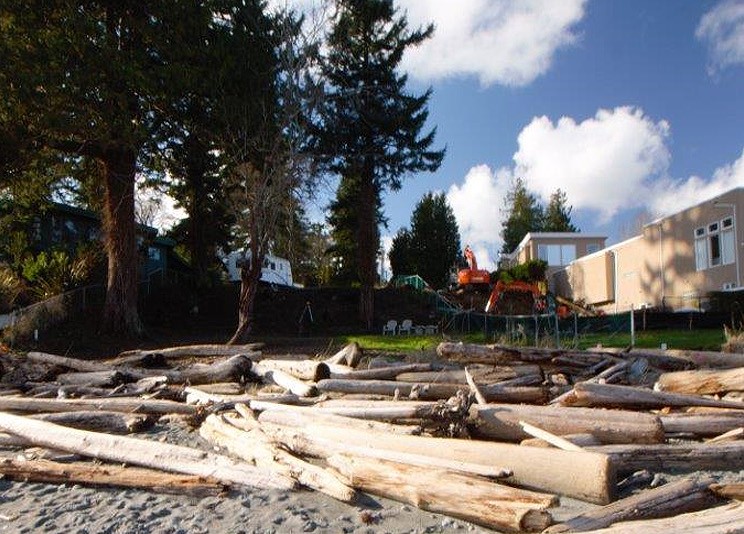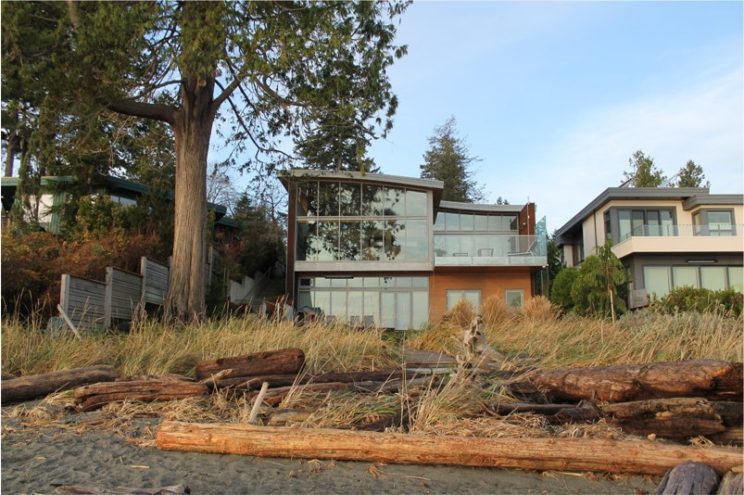Green Shores | Case Studies
Agate Lane, Saanich, British Columbia


Before

After
Project Overview
| Location: Cordova Bay, Municipality of Saanich, British Columbia | Project area: 0.22 ha |
| Year completed: 2021 | Awards: NA |
| Shoreline length: 15 m | Shore type: Marine: Sediment includes sand and cobble substrate |
| Green Shores rating achieved: GOLD | Total points: 45 |
Site Description
The shoreline has a significant intertidal zone and a gradual slope out to the aquatic environment of Cordova Bay. The sediment substrate is predominantly sand with some interspersed cobble sized material. There is significant fetch from both the SE and NW directions, and the shoreline can be subject to dynamic erosion from both high tide and storm events. This property lies north of the area designated as the Victoria Harbour Migratory Bird Sanctuary Victoria Harbour Migratory Bird Sanctuary – Canada.ca.
Project Team and Affiliated Organizations
- Design Build General Contractor: Knappett Projects Inc.
- Design Architect: Christine Lintott Architects Inc.
- Landscape Architect: Murdoch de Greeff Inc. Landscape Architects
- Environmental Management Plan: Ted Lea R.P. Bio
- Native Plant Supplier: Novus Plants
Project Objectives
- Establish an enhanced riparian area to help stabilize the foreshore from potential erosion.
- Expand the planting of native plants such as Dune Grass, retain existing large woody materials and retain overhanging vegetation to enhance habitat protection.
- Promote overall infiltration on site through development of rain gardens and use of permeable materials.
- Increase resiliency to sea level rise through location of the primary structure at a significant distance from the natural boundary, and through an enhanced riparian buffer that will dissipate wave action.
Work Plan
The newly constructed home was built with a setback that exceeded the Municipality of Saanich requirements, met Green Shores best practices for adaptation to sea level rise, and was particularly proactive given the option to build closer to the natural boundary. Rain gardens were established at different locations to collect and utilize roof run-off. Extensive native riparian vegetation plantings were installed and monitored for success. Shoreline access was designated through a wooden boardwalk.
Description of how the project meets Green Shores principles
> Maintained/ Enhanced Habitat Function and Diversity
- The riparian buffer was enhanced for a total width along 100 percent of the shoreline, and to a depth of 16 metres upland from the natural boundary. Vegetation is well established with overhanging trees such as Western Red Cedar and native plants including Dune Grass, salal, and sedges in lower lying wetter zones.
- Extra efforts (e.g., targeted irrigation) are being made to retain a large established Western Red Cedar that is being stressed by changing climatic conditions including extended summer droughts and extreme weather events. A trend impacting Western Red Cedar known as cedar die-off, is increasingly prevalent on the East Coast of Vancouver Island.
- Large woody material was retained to provide habitat for wildlife and micro-habitat for vegetation.
- The implementation of the landscape maintenance plan with best practices for the environment (e.g., no use of synthetic chemicals) protects the integrity of both the terrestrial and aquatic areas.
> Preserved/Restored Shoreline Physical Processes
- The shoreline gradient enhanced through the construction phase, provides more protection from higher water levels expected with more intense storm events and King tides.
- The retained large woody materials and installation of an enhanced riparian buffer support the natural movement of water and sediment along the shoreline while protecting the property and home from erosion.
> Ecological Services Provided
- Shoreline stabilization and erosion control from enhanced slope profile; expanded riparian zone and retention of large woody materials.
- Habitat creation from native plant installation and woody material placement.
- Increased groundwater recharge to sub-surface aquifers through creation of multiple rain gardens designed to allow roof run-off to infiltrate in-situ soils.
- Increased aesthetics through the application of a natural landscape design and an innovative and low impact shoreline access route via the boardwalk.
> Additional Notes
- The slightly raised wooden boardwalk reduces impact to the riparian by directing access to the shoreline and providing shade to smaller organisms inhabiting the shoreline area.
- The application of Green Shores best practices for the shoreline at this location showcases how Green Shores principles can both enhance habitat and protect property infrastructure. The property is now significantly more resilient to sea level rise and other potential climate change impacts. It can serve as a great example of how nature-based solutions reduce risks for the homeowner.


